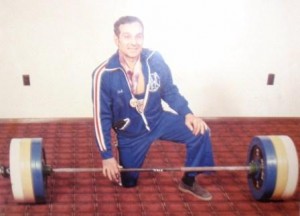Barbells Up, Dumbbells Down Part 4 – Bob Karhan
by John McKean
My all-round cohort and good buddy from Cleveland, Bob Karhan, has done more dumbbell home training than most. Very few trainees these days can match big Bob’s pure pressing power, the result of many years of concentrated work with various forms of dumbbell pressing. He’s kindly agreed to share some of his findings:
When training dumbbells I usually do 1-2 sets after my barbell exercises. For example, after a heavy press behind neck session I take a heavy pair of dumbbells and do a set of 5-6 reps in the dumbbell press. If this is fairly easy, I’ll add weight and go for on more set of 3-5 reps. If the first set proves to be a gut-buster, I’ll skip the second set.
I prefer sticking to a rep scheme of 3-8. The first rep always proves to be essential to jockey for ideal dumbbell positioning and establish coordination between muscle groups. Repetitions eventually enable one to discover a personal groove and fine tune it over the course of time. Only dumbbells permit this minute adjustment of positioning. In fact, I seriously doubt whether any two individuals could have the exact same degree of push.
In IAWA competition, the center of the ‘bell handles for presses can’t be higher than the clavicles. This presents a new level of difficulty because the initial drive requires a shoulder and elbow rotation to get the ‘bells started. This motion has a tendency to get the dumbbells out of one’s groove. By doing the exercise this way, the amount of weight is reduced by about 10-15% while shoulder aggravation is increased by 50%. It’s always important with dumbbells to work a lift in the most comfortable manner.
One other way to develop dumbbell power is to employ 2” dumbbell handles. These are hard to control and they’re tremendous for developing the grip. Mostly, when you go back to the standard 1” handles they feel like mere toys in your hands.
